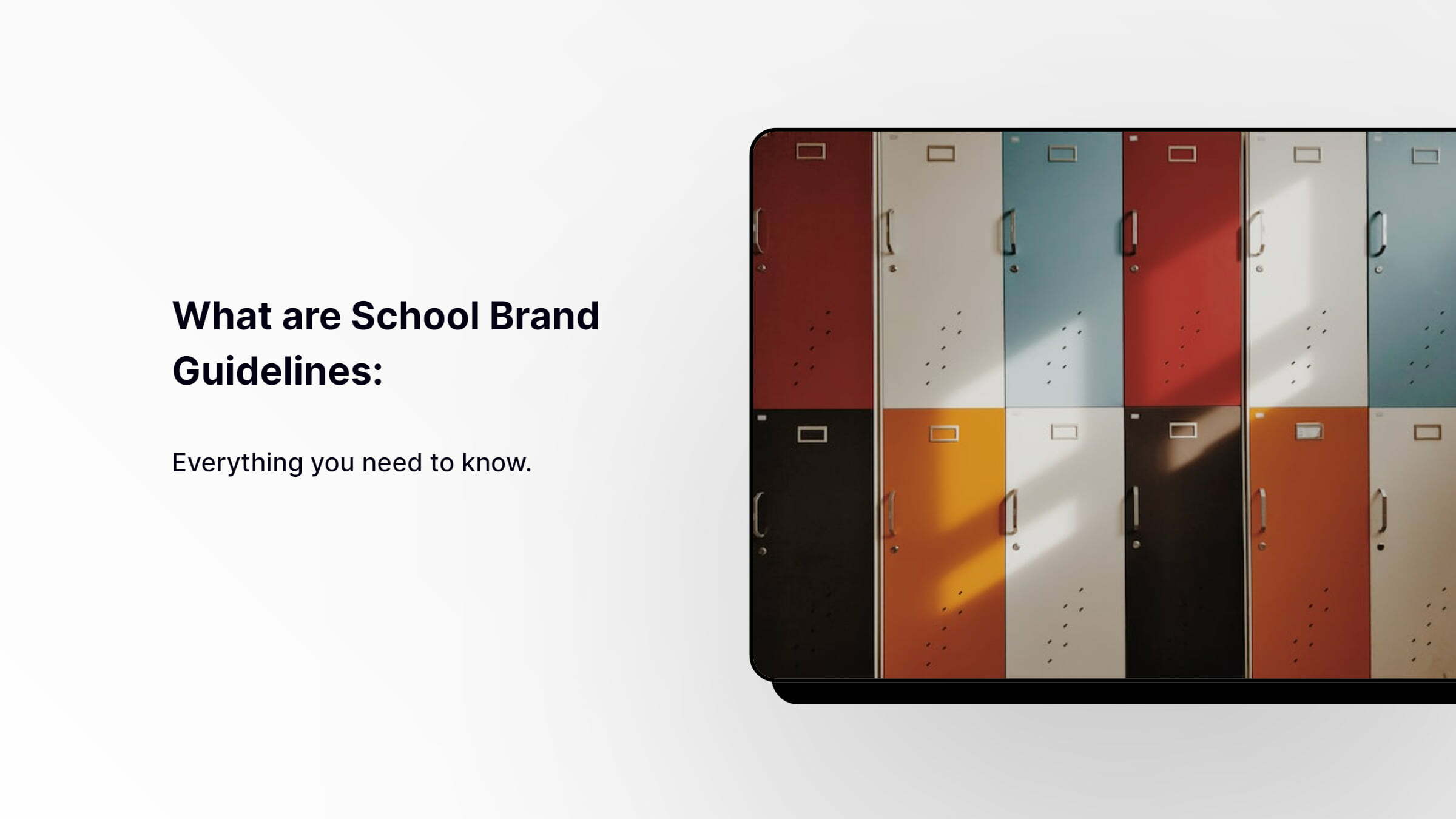Schools are complex organizations with a variety of stakeholders and constituencies.
As such, branding a school can be a daunting task. But schools must develop and maintain a strong brand identity to communicate who they are, what they stand for, and what their students can expect.
This guide will walk you through all aspects of school branding, from understanding what are school brand guidelines to developing different strategies for your brand across various channels. Let’s get started!
Table of Contents

What is a Brand?
A brand is more than just a name or logo. It is the promise of an experience. When encountering a brand, you should know what to expect regarding quality, service, and value.
A strong brand consistently delivers on its promises and, over time, comes to be associated with specific positive attributes.
For example, a luxury car manufacturer might be known for its sleek design and performance, while a fast food chain might be known for its affordability and convenience.
In today’s competitive marketplace, developing a strong brand is essential for any business that wants to stay ahead of the curve.
A brand can generate loyalty and build a passionate audience about its products or services by creating an emotional connection with customers.
Brand Identity
A brand identity is the visual aspects of a brand that identify and distinguish it from other brands.
A strong brand identity can help a company to build customer loyalty and name recognition.
Creating a consistent and recognizable brand identity requires careful planning and execution.
Every brand element, from the logo to the website design to the colour palette, should be carefully chosen to reflect the company’s values and mission.
When done well, a strong brand identity can make a company’s products and services feel more personal and trustworthy, leading to increased sales and customer satisfaction.
Branding in Schools
In today’s society, branding has become an increasingly important part of life. We are constantly bombarded with advertisements and commercials, all vying for our attention.
It is no wonder that branding has made its way into the world of education.
Schools are now beginning to market themselves to attract students and their families.
While some may see this as a cynical way to make money, others believe it is essential to providing quality education.
There are many benefits to branding in schools.
First, it can help raise awareness of the school and its programs. It is essential for schools that are struggling to attract students.
By marketing the school in a positive light, more parents will be interested in sending their children there.
In addition, branding can also help to raise funds for the school. Private schools, in particular, often rely on donations from alums and other supporters.
A strong brand can help to increase these donations by making the school more visible and attractive to potential donors.
Finally, branding can also help to improve the morale of students and staff. People who feel proud of their school are more likely to be engaged and motivated in their work.
In short, branding can positively impact every aspect of a school’s operation.
While there are some drawbacks to branding in schools, such as the potential for commercialization, the benefits far outweigh the costs.
Schools need to do everything they can to stand out from the crowd in a world where competition is constantly increasing. Branding is one way to ensure your school is seen and heard above the rest.
What are School Brand Guidelines:
School brand guidelines dictate how a school’s name, logo, colours, and other visual elements should be used.
These guidelines ensure that a school’s visuals are used consistently across all communications, from website to print materials to signage.
It helps to create a unified look that is easily recognizable and reinforces the school’s brand.
Brand guidelines usually cover logo usage, colour palette, typography, and iconography.
They may also provide templates for everyday communications, such as letterhead and business cards.
By following these guidelines, schools can ensure that their visuals make a strong and consistent impression.
Why do Schools need Brand Guidelines:
They create consistency

There are many reasons why schools need brand guidelines. Perhaps the most important reason is that they help to create consistency.
A consistent brand is easily recognizable and creates a sense of trust. Brand guidelines also help ensure that all school communications are aligned with its core values.
It can be essential for schools that are trying to build a positive reputation in the community.
Brand guidelines can also help save time and money by providing a clear roadmap for creating marketing materials.
By having a set of guidelines to follow, schools can avoid the need for expensive marketing consultations.
Ultimately, brand guidelines provide an essential framework for promoting a school and its unique identity.
They keep external providers on the same page

Schools need brand guidelines to ensure everyone works from the same visual playbook.
When multiple providers are involved in creating materials for a school, it’s essential to have a set of guidelines to keep everyone on the same page.
Brand guidelines help to maintain a consistent look and feel across all school communications, from the website to print materials.
They also help to create a cohesive overall brand identity for the school. Schools can ensure that all communications align with their vision and values by having clear brand guidelines.
They increase parent recall

While a school’s primary mission is to provide an excellent education for its students, many other factors contribute to a school’s success.
One of these is parent recall, which refers to how easily parents can remember and identify the school. Strong branding can play a crucial role in increasing parent recall, as it helps to create a distinctive and memorable identity for the school.
It, in turn, can lead to increased enrollment, donations, and more significant community support. Of course, creating an effective brand requires more than just coming up with a catchy name and logo.
It also requires having a clear set of guidelines that govern how the brand should be used. Schools need brand guidelines: to ensure that their branding is consistent, recognizable, and impactful.
What should be included in your school’s brand guidelines?
Every school has its unique identity, and it’s essential to ensure that this comes across in all your marketing materials. Therefore, the things that should be included in your school’s brand guidelines are:
Your school’s motto, ethos, or slogan

A school’s motto, ethos, or slogan provides a unifying message that can be used to communicate the school’s values and culture to students, staff, and the wider community.
When developing brand guidelines, it is essential to consider how these elements can be used to create a consistent and memorable brand identity.
The motto, ethos, or slogan should be prominently featured in all marketing and communications materials, including the website, stationery, and signage. It should be used consistently across all channels and supported by visual elements that reinforce the message.
By carefully considering how these elements can be used, schools can develop a solid and distinctive brand identity that will help to bring their community together.
Your USP or elevator pitch

When promoting your school, it’s essential to have a solid and clear USP or elevator pitch.
It is a short statement summarising what makes your school unique and why prospective students should choose you over other options.
Including your USP in your brand guidelines is essential so that everyone promoting your school – from teachers and counsellors to marketing staff – is on the same page.
It ensures that your message is consistent and that everyone understands what makes your school special. With a strong USP, you can make sure that prospective students understand why your school is the best choice for them.
Logos

A school’s logo is a vital part of its branding. It should be used consistently across all communications, from letterhead and business cards to websites and social media.
A school’s logo should be simple, memorable and easy to reproduce. The logo should also be scalable to be used effectively on large and small applications.
The use of colour is also essential, as it can help to create a distinctive identity for the school.
Schools should consider how their logo will be used across all mediums when developing brand guidelines.
By doing so, they can ensure that their branding is consistent and recognizable, ultimately helping to create a strong and unified identity for the school.
Colours

Any school looking to develop a new brand identity or refresh its existing one must consider their school colours carefully.
These colours will be essential to the school’s visual identity and should be used consistently across all communications, from stationery and prospectuses to websites and social media.
When choosing school colours, it’s essential to consider how they will work with the school’s logo and other graphical elements.
It’s also worth considering any existing colour associations the school may have – for example, many schools use blue and gold to signify their academic excellence.
Once the school colours have been decided upon, they should be documented in the brand guidelines so that they can be used consistently by all members of the school community.
Typography

A school’s typography is an integral part of its brand identity. The style and appearance of the school’s typeface can say a lot about the school’s values and character.
That’s why schools need to develop brand guidelines that include clear instructions on how to use the school’s typography.
The guidelines should cover everything from fonts for different purposes to how to format text for other mediums.
By developing a comprehensive set of brand guidelines, schools can ensure that their typography always conveys the right message.
Imagery

A school’s imagery is one of its most important brand assets. The right images convey the school’s values, mission, and spirit and help to differentiate it from other institutions.
Therefore, when developing a school’s brand guidelines, it is essential to consider the role that imagery will play carefully.
The guidelines should specify the types of images that are to be used, as well as how they are to be used.
For example, the guidelines might stipulate that only images of the school’s campus are to be used in marketing materials or that all photos must be high-resolution to maintain a consistent look and feel.
By thoughtfully crafting its brand guidelines, a school can ensure that its imagery reinforces its core message and distinguishes it from the competition.
Frequently Asked Questions:
What is a school’s USP?
A school’s USP, or Unique Selling Proposition, makes it stand out from other schools. It should be something that prospective students understand and appreciate about the school.
Why is a logo important for a school?
A school’s logo is crucial because it visually represents the school’s brand. It should be simple, memorable and easy to reproduce, and should be used consistently across all communications.
What are some things to consider when choosing school colours?
When choosing school colours, it’s essential to consider how they will work with the school’s logo and other graphical elements. It’s also worth taking into account any existing colour associations that the school may have.
What is the role of typography in a school’s brand identity?
A school’s typography is an integral part of its brand identity. The style and appearance of the school’s typeface can say a lot about the school’s values and character. That’s why schools need to develop brand guidelines that include clear instructions on how to use the school’s typography.
Why is imagery important for a school?
A school’s imagery is one of its most important brand assets. The right images convey the school’s values, mission, and spirit and help to differentiate it from other institutions. Therefore, when developing a school’s brand guidelines, it is essential to consider the role that imagery will play carefully.
The Bottom Line:
School branding guidelines are essential to a school’s overall marketing strategy. By creating and following clear branding guidelines, schools can ensure that their marketing efforts are consistent and on-brand.
A well-branded school can create positive perceptions among students, parents, and the community, leading to increased enrollment and other benefits. If you’re looking to create or update your school’s branding guidelines, use this guide as a starting point.
And you if are looking for some of the best professionals to help you build your school’s brand. Contact us today!




